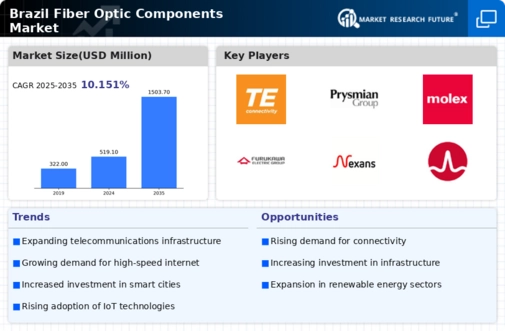Growing Demand for Data Centers
The growing demand for data centers in Brazil is significantly impacting the fiber optic-components market. As businesses increasingly rely on cloud computing and data storage solutions, the need for efficient data centers has surged. In 2025, the data center market in Brazil is projected to reach $3 billion, driven by the expansion of digital services and e-commerce. This growth necessitates the deployment of high-performance fiber optic components to ensure fast and reliable data transmission. Consequently, the fiber optic-components market is likely to benefit from this trend, as data center operators seek to enhance their infrastructure to meet the rising demand for data services.
Increasing Internet Penetration
The fiber optic-components market in Brazil is experiencing growth due to the increasing penetration of internet services across urban and rural areas. As of 2025, approximately 75% of Brazilian households have access to the internet, a notable increase from previous years. This surge in connectivity drives demand for high-capacity fiber optic components, as service providers seek to enhance their infrastructure to accommodate the growing number of users. The Brazilian government has also been promoting initiatives to expand broadband access, which further stimulates the fiber optic-components market. With the rising need for reliable and fast internet, the market is likely to see a compound annual growth rate (CAGR) of around 10% over the next five years.
Rising Adoption of Smart Technologies
The fiber optic-components market in Brazil is being propelled by the rising adoption of smart technologies across various sectors. Industries such as healthcare, manufacturing, and transportation are increasingly integrating smart solutions that rely on high-speed data transmission. For instance, smart cities initiatives are gaining traction, with investments projected to reach $2 billion by 2026. These initiatives necessitate robust fiber optic networks to support IoT devices and real-time data analytics. Consequently, the demand for fiber optic components is expected to rise as businesses and municipalities seek to implement these advanced technologies, thereby enhancing operational efficiency and service delivery.
Increased Focus on Renewable Energy Solutions
The fiber optic-components market in Brazil is also influenced by the increased focus on renewable energy solutions. As the country aims to diversify its energy sources, investments in renewable energy projects, such as wind and solar, are on the rise. In 2025, it is estimated that investments in renewable energy infrastructure will surpass $10 billion. These projects often require advanced communication systems for monitoring and control, which rely on fiber optic technology. As a result, the demand for fiber optic components is expected to grow, as energy companies seek to implement efficient communication networks to support their renewable energy initiatives.
Expansion of Telecommunications Infrastructure
The expansion of telecommunications infrastructure in Brazil is a critical driver for the fiber optic-components market. Major telecommunications companies are investing heavily in upgrading their networks to support higher data transmission rates. In 2025, it is estimated that investments in fiber optic infrastructure will exceed $5 billion, reflecting a strong commitment to improving connectivity. This expansion is particularly evident in underserved regions, where the deployment of fiber optic technology is essential for bridging the digital divide. As a result, the fiber optic-components market is poised for growth, as these companies require advanced components to support their upgraded systems and meet the increasing demand for data services.

















Leave a Comment